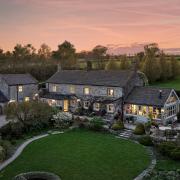The countdown to the opening of a world class showcase of modern art in the heart of Yorkshire has begun as Wakefield prepares to honour two giants of contemporary sculpture. Terry Fletcher reports
Art lovers have been given their first peep inside the new Hepworth Wakefield as the controversial gallery now nearing completion on the city’s regenerated Waterfront opened its doors for a string of previews.
The shell of the strikingly modern main building, designed by award-winning architect David Chipperfield, was finished earlier this summer allowing it to stage a series of lectures and children’s workshops before work began on fitting out the interior.
Frances Guy, the Hepworth’s Head of Collections, said: ‘A lot of people have strong feelings about the outside of the building and we wanted them to see the fantastic arts spaces which have been created. I think they were blown away by what they saw and by the views from the buildings. It was a wonderful opportunity and I think we’ve changed a lot of opinions.’
When the centre, dedicated to sculptor Dame Barbara Hepworth who was born in the city, opens next May it will confirm the area as one of Britain’s key artistic destinations. Combined with the nearby 500 acre Yorkshire Sculpture Park at West Bretton and the Henry Moore Institute just up the M1 motorway in Leeds it will add up to a display of modern sculpture unrivalled anywhere in the country.
But the displays will go far beyond just sculpture and its collection of 20th century British art is considered to be one of the finest outside London. It features works by many of the country’s best-known artists, including Hepworth’s second husband, Ben Nicholson, Ivon Hitchens, Graham Sutherland, Paul Nash, John Piper, Jacob Epstein, David Bomberg, Walter Sickert, Anthony Caro, LS Lowry and David Hockney.
The Hepworth will also have access to the national collection of modern art thanks to a partnership deal with London’s Tate Gallery. Its acceptance as part of the Tate Connects Programme is seen as a national vote of confidence in the new venture, placing it firmly on Britain’s cultural map as well as opening doors to even more exciting exhibitions.
Wakefield is the ideal location for the Hepworth as the area produced the two giants of 20th century British sculpture, born just five years and a dozen miles apart. Henry Moore, renowned for his huge curved and pierced abstract figures was born in Castleford in 1895, five years before Hepworth. They were contemporaries at the Leeds School of Art before going on to study at the Royal College of Art in London and both will feature strongly in the galleries at the Hepworth.
Critics have speculated whether their emergence so close together was merely coincidence or was somehow formed by the time and landscapes in which they grew up. Dame Barbara acknowledged the impact of the Yorkshire countryside on her work and wrote: ‘All my early memories are of forms and shapes and textures. Moving through and over the West Riding landscape with my father in his car, the hills were sculptures: the roads defined the forms.’
She was also keen for Wakefield to have at least one significant piece of her work. Three figures from her nine-piece group, Family of Man already stand outside the former County Hall in Wood Street, where her father once worked, but when the new galleries open her presence in the city will go much further than that.
At the heart of the displays will be 40 pieces, many of them never seen in public before. They have been donated by the Hepworth estate, which became guardians of her legacy after Dame Barbara died in a fire at her studio in St Ives, Cornwall, in 1975. They include several maquettes, the initial small scale models of sculptures, as well as the plaster mouldings from which several of her finished bronzes were cast.
‘Through these pieces visitors will be able to explore the creative process and see how her ideas developed,’ said Frances. ‘Indeed, it has been said that they contain more Hepworth DNA than the finished bronzes because these are the actual models she physically worked on herself. They are particularly intriguing because she also used them as a basis for working out the colourways for the final bronzes and some of them are quite brightly coloured.’
Afterwards visitors will be able to see some of her monumental landscape works, including a full set of the Family of Man, outdoors at the Yorkshire Sculpture Park, which also contains a fine collection of Henry Moores displayed against the classical backdrop of the 18th century grounds of Bretton Hall and the reclaimed industrial landscape of the spoil heaps of the former Woolley Colliery.
But before that can happen there are months of work to complete fitting out the galleries and landscaping the outside of the building. But those behind the Hepworth are confident that when the doors open Wakefield will have a world class gallery to be proud of.


























